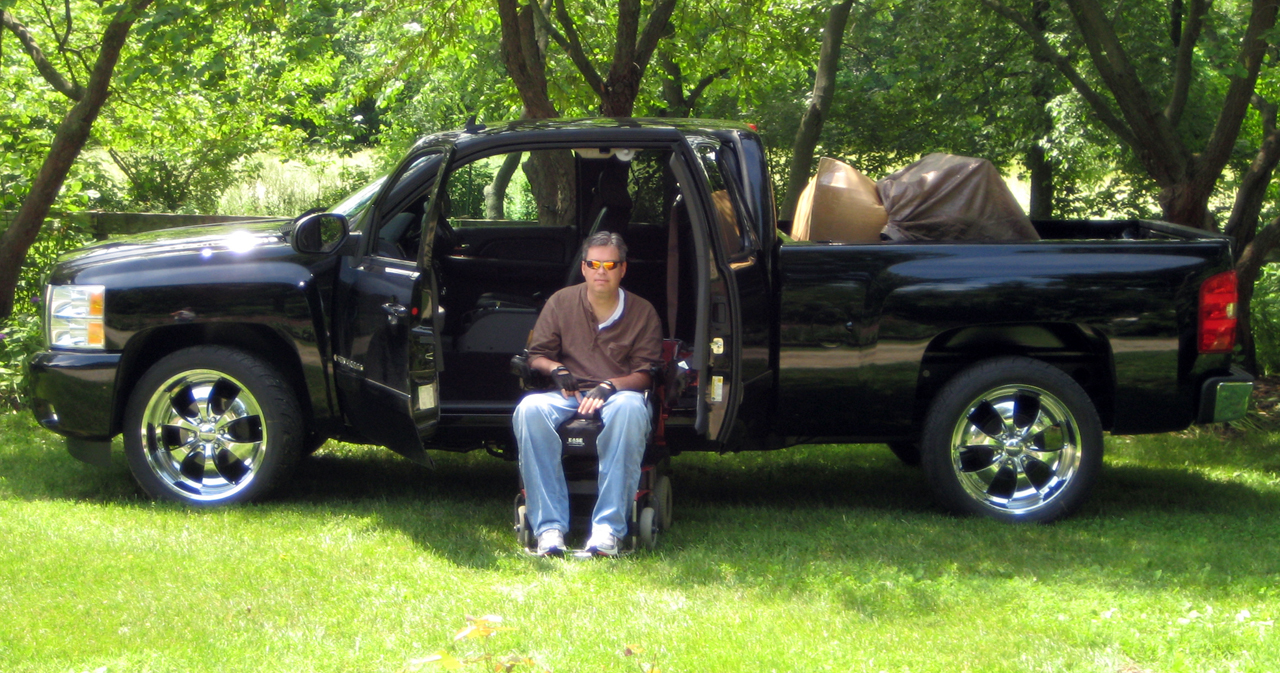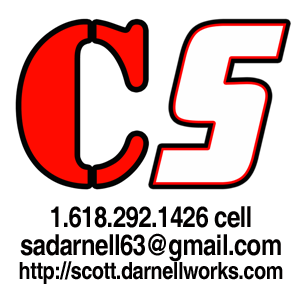
Last Updated May 13, 2015: Scott Darnell Wins Top Mobility Industry Engineering Award, Brings Custom Mobility Solutions to Market
Creative and Communications Campaign Designed and Executed by The Darnell Works Agency Supports Growth For Ambitious Entrepreneur
See also: WEBSITE
 Adaptive mobility expert Scott Darnell is a consultant and developer of innovative solutions for wheelchair users.
Adaptive mobility expert Scott Darnell is a consultant and developer of innovative solutions for wheelchair users.
Executive Summary
In 2003, DWA began its role as the creative and communications agency of record for Changing Stares, Inc., a privately held start-up focused on creating important new mobility options for wheelchair users. With Scott Darnell (brother to DWA principal Roger Darnell) unveiling his first product at the 2006 SEMA Show in Las Vegas, DWA took responsibility for all facets of brand communications for the company’s successful launch. In 2009, Scott was invited to attend the annual conference for the National Mobility Equipment Dealers Association, where Adaptive Driving Alliance leaders presented him with their New Technology Award for innovation in engineering and technology for the physically challenged. As the venture has progressed, it has tapped DWA’s expertise to cost-effectively advance essential facets of its business, including sales and customer service. Thanks to Scott’s perseverance and DWA’s ongoing support, CSI has earned vital media exposure and consistently expanded dialogues with industry experts and customers through adept communications that include dynamic use of social media.
Challenge
The specialty automotive industry represents an exploding marketplace – where sales for 2005 exceeded $30 billion. To tap their share, the best players – ranging from all the major automotive manufacturers down to regional shop-owners specializing in vehicle customizations and accessories – employ proactive sales and marketing tactics, with the goal of driving customer purchases. Naturally, it’s a marketplace where the playing field can be quite fierce. In one of its niches, approximately 100,000 vehicles are sold each year that are then modified for drivers with various disabilities… and adaptive mobility systems are in increasing demand. Many well-funded, long-standing businesses exist across the country to serve the needs of these drivers, but one of them – who happens to be my older brother, Scott Darnell – found an under-served niche, based upon his own personal needs. In 1995, at the age of 27, Scott had a diving accident that left him a C-5/6 quadriplegic, and after his dozen years of driving sports cars and cool trucks, he suddenly found himself looking very handicapped, driving the only choice he could afford to have suitably modified, a full-size Ford van. He immediately set out to create a new system to allow himself and others like him to drive a cool truck. He painstakingly researched every option available, and with a lot of help along the way from many people – and through his own determination and persistence – he eventually formed Changing Stares, Inc. The product debuted at the 2006 SEMA Show, the largest and most prominent annual automotive showcase in the world, it fell to DWA to provide strategy, business, marketing, public relations and sales consultation – and execution – to move CSI over the R&D threshold, and into business.
Approach
During 2004, Scott knew he had something phenomenal to offer the marketplace, and he made plans to reach out to every major competitor to try to get his DMS system licensed for distribution. To support that initiative, I executed a vision for a logo, produced a demo video of the working lift system, created and launched a website, and provided extensive business counsel. Although none of the companies contacted decided to take-on the system, virtually every person contacted signed a non-disclosure agreement, expressed considerable interest, and became a valuable business contact. Two years and a great deal of R&D progress later, Scott decided to debut the latest version of his product, the DMS-3, at the forthcoming SEMA Show in Las Vegas. With less than six weeks to pull everything together, I took on the branding, marketing and communications challenges. The logo was redesigned, the booth was designed – and collateral materials, shirts and booth banners were all designed, printed and shipped. The website was completely redesigned and updated with elements as they came together – including company positioning information, executive bios, downloadable artwork and a new sales brochure. A Blog was conceived, launched, registered and utilized as a major promotional/communications tool. New video material was gathered and a demo video produced for the website and the booth. The list of 1,300 attending members of the media was analyzed and broken down, with 120 key targets identified. A press release was widely distributed a week before the show kick-off. From there, I worked to hone the sales, marketing and communications strategy, creating custom sales presentations and press kits. Throughout the final weeks leading up to SEMA, I posted daily updates to the website and the blog, and worked with Scott to launch a viral marketing campaign to ensure that various communities of interest were made aware of the lift and our plans for participation in the big event in Las Vegas.
Results – Highlights
- The SEMA booth was among the multimillion dollar extravaganza’s more modest displays, and yet the combined effect of the picture-perfect demo unit, the spot-on messaging on the banner, the powerful demo video and the well-crafted collateral materials successfully conveyed the excitement and breakthrough nature of the DMS-3 system.
- Booth visitors included many members of the media following-up on the pre-show press outreach, mobility equipment dealers, vehicle customization specialists and automotive industry professionals.
- Many conversations began with visitors expressing interest in the product for those they knew in wheelchairs, and quickly progressed to them being totally impressed by the product itself, the presentation, and the possibilities. It was literally Scott’s dream coming true.
- The booth also attracted engineers and executives from some of those major competitors contacted in 2004 – each of whom expressed impressed approval and opened the door for further discussions.
- Outside of Las Vegas, before the show ended, the video had been watched over 1,000 times on the website, and message boards buzzed about the amazingly cool new offering for drivers in wheelchairs.
- Launch press coverage included front-page news stories in Scott’s hometown newspaper, and coverage (with color photos) in Trucking Times, Truck & SUVs Magazine, P/N: Paraplegia News.
- Over time, Scott has counseled medical professionals, others with spinal injuries and their families, transforming his experiences and dreams into numerous inventions aimed at helping create important new mobility options for others in chairs. News of Scott’s accomplishments has furthered his renown as a real-life hero to many.
- In 2009, Scott was invited to attend the annual conference for the National Mobility Equipment Dealers Association, where Adaptive Driving Alliance leaders presented him with their New Technology Award for innovation in engineering and technology for the physically challenged.
- In 2015, Scott and DWA launched AnAbility.com, a source for custom ability reports focusing on personal mobility for wheelchair users.
About The Darnell Works Agency
With its proven expertise in developing highly successful marketing, PR, and media strategies, The Darnell Works Agency is the go-to PR firm for bold business leaders and their organizations. Offering unmatched writing talent and inside-media expertise, agency principal Roger Darnell sets his clients apart atop their industries. Already central to billions of positive media impressions worldwide, the agency’s collaborations with leading business executives and media luminaries continue soaring to new heights.